Article Archive
Methods of Inspection to Determine the Presence of Potential Arc Flash Incidents
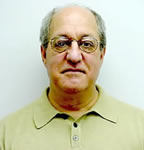 Mark Goodman |
 Doug Waetjen |
Mark Goodman, Author UE Systems, Inc. Email: Email: |
Abstract
Using ultrasound to scan around door seals and air vents prior to opening for an infrared inspection can help detect the presence of arcing, tracking, or corona, especially if there are no scan ports in the equipment. This multi-technology approach is recommended as an excellent tool for increasing safety of personnel while reducing the potential for an unfortunate accident. This presentation will review the suggested methods and approaches for detecting the presence of arc flash potential in enclosed, energized electrical equipment by simultaneously using ultrasound and infrared technologies.
Introduction
Arc flash can kill. It is considered a short circuit through the air and produces tremendous stored up energy that will travel outward from electrical equipment. An arc flash produces temperatures as high as 35,000 oF, which is hotter than the sun, and produces a force that is equivalent to being hit by a hand grenade. The impact is so high it can cause hearing and memory loss. If it doesn’t kill you, it will severely burn or injure you. In addition, the conditions that produce an arc flash, even when no arc flash occurs, will also lead to damage of electrical equipment causing unplanned outages and costly downtime. Statistics show that 5-10 arc flash explosions occur in electrical equipment daily within the United States1. Unreported instances are reputed to be several times greater. Many victims are so badly burned that they require treatment at special burn centers.
In the US, the Occupational Safety & Health Administration (OSHA) has become aggressive in their attempts to reduce arc flash incidents and has begun to use the National Fire Protection Association’s NFPA 70E Standard for Electrical Safety Requirements for Employee Workplaces2, as the guide for compliance to help ensure worker safety. There are standards for arc flash assessment, types of PPE (Personal Protective Equipment), working around energized equipment, and opening enclosed equipment, to name a few. All of these standards are geared toward worker safety.
Discussion
 There are many causes of arc flash. It can occur in any electrical equipment regardless of voltage.
There are many causes of arc flash. It can occur in any electrical equipment regardless of voltage.
Arc flash incidents can happen from poor work habits, dropping of tools, or accidental contact with energized equipment. However, there are conditions that produce potential for arc flash within enclosed cabinets that can be detected before creating flashover or arc flash incidents. These conditions are arcing, tracking, and corona.
While infrared thermography will detect heat generated by arcing, and in most instances tracking, it will not sense corona. If cabinets are enclosed, unless there is an infrared test port, it is highly unlikely that infrared will detect the presence of these emissions. In addition, to view components within enclosed electrical cabinets, it is necessary to conform to NFPA standards with regards to PPE. Therefore, in many situations, thermographers must wear cumbersome clothing and hoods to perform the required procedure to open cabinets for inspection. This can be very time consuming and, in hot weather, very uncomfortable. An integrated approach incorporating infrared and ultrasound is recommended for the detection of the potential for arc flash.
Arcing, tracking and corona emissions produce ionization. Ionization is a process by which a neutral atom or molecule loses or gains electrons, thereby acquiring a net charge and becoming an ion. This occurs as the result of the dissociation of the atoms of a molecule in solution or of a gas in an electric field2. Ionization has by-products: ozone and nitrogen oxides. These combine with moisture to produce nitric acid, which is destructive to most dialectics and certain metallic compositions, resulting in corrosion.
The object of electric condition monitoring is to detect the presence of these events before flashover* occurs or before they produce an arc flash incident when a cabinet is opened.
Air/structure borne ultrasound technology is ideally suited for detecting these emissions since the ionization process produces ultrasound emissions. Ultrasonic instruments sense between 20-100 kHz and use heterodyning to translate the ultrasonic emissions into the audible range. These portable instruments provide information via headphones for the audio signal and on a meter to display intensity readings, usually as decibels. These hand-held devices usually contain two sensing heads with piezoelectric transducers: a scanning module for airborne sounds and a contact probe/wave-guide for structure borne signals.
How Portable Instruments are Used to Detect Potential Failure and Arc Flash Conditions
Typically, an operator will scan around the door seams and air vents of enclosed electrical cabinets with the scanning module while listening through headphones and observing a display panel. Arcing, tracking and corona all have distinct sound qualities. If there are no air paths, the inspector will use the wave-guide to probe around the cabinet wall. Due to a possible change in wave characteristics as the ultrasound moves from airborne to structure borne, the operator will change the frequency from 40 kHz (effective for airborne scans) to 25 kHz. Should there be a need to analyze these patterns further, the sounds can be recorded and played back on spectral analysis software. Voltage will also play a role in the diagnosis since corona will only occur at 1,000 volts and higher.
The Advantage of Spectral Analysis
There may be instances where it is difficult to determine the type of problem heard through the headphones. In these situations, a sound recording of the condition can be made (some instruments have onboard sound recording capability) and viewed on spectral analysis software. The sounds may be heard in real time as they are viewed on an FFT or time series screen for analysis. This enables inspectors to observe subtle problems that might be missed by just viewing a screen without sound. As an example, the following screen shows a transformer with a typical transformer hum. By just observing the screen, the condition of loose windings might have been overlooked. The sound sample, showing a buildup and drop off of the sound along with movement on the screen, highlighted this condition.
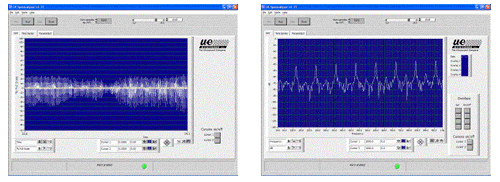
If any of these conditions are detected, the potential for arc flash exists and operators will be prepared to follow the correct procedures to safely open the component and repair the condition. Infrared scans can be taken to confirm the diagnosis and to identify any additional problems that would generate heat, but not sound.
We are often asked at which voltages and on what type of equipment is ultrasound most effective. The answer is not simple since it often depends on the individual asking the question. First of all, determining the definition of low, mid and high voltage is relative. Those in the power distribution arena will look at 12 kV as low voltage; those who work in a typical manufacturing plant will look at 440 volts as high voltage. The main electrical problems detected ultrasonically are partial discharge, arcing, tracking, and corona. Ultrasound detects the ionization of air as it produces turbulence. This can be from corona, tracking or arcing. Heat is produced when there is either resistance due to corrosion or from tracking and arcing. Since heat is produced by the flow of current through corrosion or resistance, you can have a “hot spot” detectable with infrared, and have no ultrasound emissions because there would be no ionization.
Low Voltages: The main concern in low voltage equipment is arcing. Typically, 110, 220 and 440 volt systems are inspected with infrared imaging and/or spot radiometers for temperature changes. Hot spots, usually an indication of resistance, can be indicative of a potential for equipment failure or it could indicate a possible fire hazard. When arcing occurs, it is often accompanied by heat. However, it is not always possible to detect a hot spot if the equipment is covered. Ultrasound will hear arcing in circuit breakers, switches, contacts and relays. In most instances, a quick scan of a door seal or vent will detect the ultrasound emission. Listening for internal arcing in circuit breakers and switches can be accomplished with a contact probe. For example, touch a circuit breaker switch with the contact probe to listen for internally generated arcing. The most effective method of low voltage inspection is to combine infrared imaging with an ultrasonic probe. Please keep in mind that since air cannot be a conductor of electricity below 1000 volts, corona cannot exist. Any “buzzing” sounds are caused by either loose components vibrating at 60 or 50 Hz or by tracking.
Mid & High Voltage: Higher voltages often produce more potential for equipment outage. Problems such as arcing, corona, destructive corona, or tracking (sometimes referred to as “baby arcing”) as well as partial discharges and mechanical looseness all produce detectable ultrasound emissions that warn of impending failure. Detecting these emissions is relatively easy using ultrasound. The acoustic difference among these potentially destructive events is the sound pattern. Arcing produces erratic bursts, with sudden starts and stops of energy, while corona is a steady “buzzing” sound. Destructive corona has a build up and drop-off of energy resulting in a buzzing sound accompanied by subtle popping noises. While scanning for these emissions, use a parabolic reflector. This accessory can more than double the detection distance of the standard scanning modules.
Partial discharge (PD), which occurs inside electrical components such as in transformers and insulated bus bars, is another problem that can be detected with ultrasound. Partial discharge can be quite destructive. It is affected by and causes deterioration of insulation. This is heard as a combination of buzzing and popping noises. The contact probe is employed for PD detection. If your instrument has frequency tuning, try 20 kHz.
Analysis of Recorded Signals
While it is relatively easy to determine arcing, tracking or corona by the sound pattern, there can be occasions where it may prove confusing. It may be possible that a strong buzzing sound related to corona might in fact be nothing more than mechanical looseness. Spectral Analysis and Time Domain can be useful tools in analyzing electrical emissions. Since all Ultraprobe instruments heterodyne ultrasound down into the audible range, either the headphone jack or the instrument itself, Ultraprobe 10000, may be used to record sounds. You must use a suitable recording device that has a suitable bandwidth in the lower frequencies. Digital voice recorders are not acceptable as they only can record signals above 300 Hz, which is not low enough to be useful for the 50 or 60 Hz peaks. Laptop computers, MP3 recorders or quality cassette recorders work well for recording signals in the field. When recording the signals, you need to make certain that the signal is not distorted. On analog instruments, you should not let the signal go over 50% of full scale on the signal strength indicator. On the digital instruments, you should try to maintain the signal strength between 4 to 6 segments of the bar graph.
These sounds can then be downloaded to a computer with a sound card and viewed as a spectrum or time series for analysis. It is necessary to examine both the Spectrum and the Time Domain images when you are trying to evaluate what is going on. The main harmonic of an electrical emission (60 Hz in the USA, 50 Hz elsewhere) will be most prevalent in corona. As the condition becomes more severe, there will be fewer and fewer 60 Hz harmonics observed. As an example, arcing has very few 60-cycle components. Mechanical looseness will be rich in 60 Hz harmonics and will have little frequency content between the 60 Hz peaks and will also demonstrate harmonics other than 60 Hz.
Examining the Time Domain image can also be of help. In the case of corona, you will have a uniform band of signal with very few peaks that extend above the average band. With tracking, you will begin to see that the peaks created by the discharges extend above the average band. With arcing, you will see several bursts of energy which correspond with the discharges. In all cases, both the Spectrum and the Time Domain should be examined before a final determination is made.
Below you will find examples of both the Spectrum and Time Domain views for the varying degrees of severity of discharge to atmosphere.
Corona:>
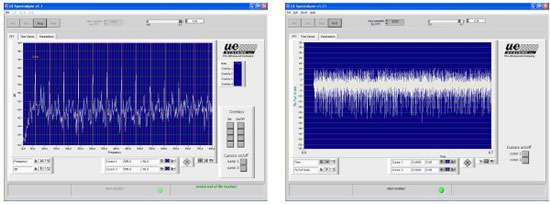
Tracking:
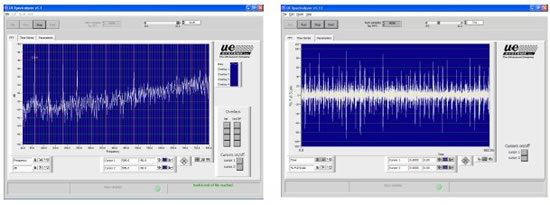
Bad Tracking:
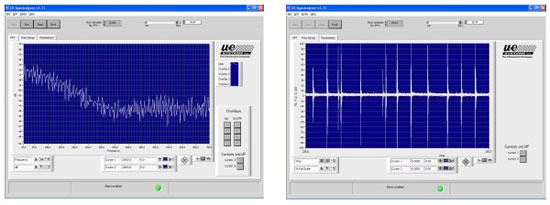
Arcing:
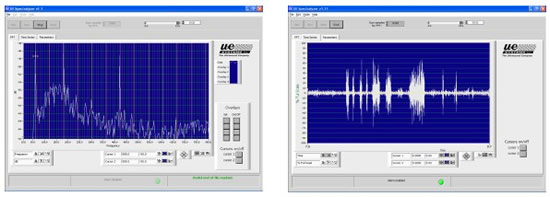
Loose or Vibrating Component:
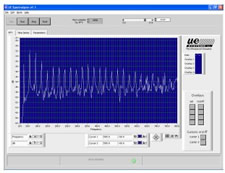
New On-line Condition Monitors
While a great majority of the inspections around energized electrical equipment incorporate portable instruments, these inspections are limited in their ability to protect equipment from failure or from detecting an arc flash potential. These limitations are time-based. If an inspector is testing at the time any of these incidents is occurring, there is a good chance they will be detected and reported for corrective action. But, unlike mechanical conditions which are usually detected first and then trended to specific action levels, once arcing, tracking or corona are present, there is a potential for failure and arc flash that can occur at any time. Therefore, there is need for continuous on-line monitoring of enclosed electrical equipment.
An electrical cabinet monitor is mounted on the internal side of a door or wall facing the components. Utilizing an airborne scanner, a threshold level is set. Should an event of arcing, tracking or corona occur, the sound level will be above the ambient threshold and it will be detected. A 4-20 mA or 0-10 VDC output can be selected to carry the signal to an alarm mechanism or red light alert. In addition, these units contain a heterodyned signal to provide recording capability for record keeping and analysis purposes.
The advantage of on-line monitoring is obvious, it is not operator dependent and will continuously monitor. Whenever a condition occurs to produce the potential for arc flash or flashover*, it will be sensed and alarmed instantly.
Conclusion
Ultrasound inspection is an effective screening tool for detecting the potential for arc flash incidents. When hand-held ultrasonic instruments are used to scan enclosed electrical apparatus, the procedure is fast, accurate, and simple. It can help inspectors by eliminating the need for wearing cumbersome, uncomfortable PPE during a preliminary survey. On-line continuous monitors can alarm personnel of the presence of arcing, tracking and corona in advance of an inspection.
References
1. “Preventing Arc Flash Incidents in the Workplace”, George Greggory, EC&M June 2003
2. National Fire Protection Association, 1 Batterymarch Park, Quincy, MA 02269
3. www.hatch.com Glossary of chemical terms
* Flashover (according to Merriam-Webster’s New Collegiate Dictionary) is an abnormal electrical discharge (as through the air to the ground from a high potential source or between two conducting portions of a structure).
Advertisement

